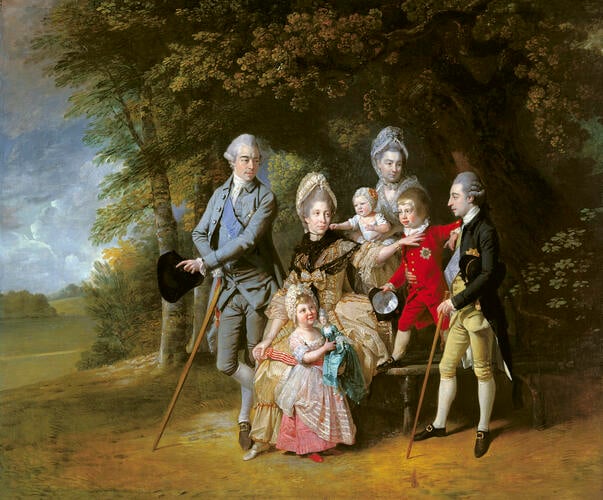-
1 of 253523 objects
Queen Charlotte (1744-1818) with members of her family c.1771-2
Oil on canvas | 105.3 x 127.0 cm (support, canvas/panel/stretcher external) | RCIN 401004

Johan Joseph Zoffany (Frankfurt 1733-London 1810)
Queen Charlotte (1744-1818) with members of her family c.1771-2
-
This, unlike some of Zoffany's interior portrait scenes, is a public image, exhibited at the Royal Academy as a 'Portrait of her Majesty, in conversation with her two brothers and part of the Royal family'. It remains a classic conversation piece, exhibiting the happy hubbub of affectionate relationships within an extended family.
It records the presence in London in 1771 of both Queen Charlotte's beloved elder brothers, and must have been finished before Zoffany's departure for Florence in 1772. Prince Karl of Mecklenburg-Strelitz (1741-1816) stands on the Queen's right, wearing the order of St Andrew of Russia; Prince Ernst (1742-1814), stands to her left sporting the white eagle of Poland. Both men are dressed with the distinctively unostentatious elegance of English fashion, in frock coats (a servant's coat with turned down collar adopted by the ton as early as the 1720s), holding chapeau bras (literally 'arm-hats', to be held not worn) and carrying canes rather than swords. The royal children can be identified with less confidence: the girl holding a doll is certainly the Princess Royal (Charlotte 1766-1828); the boy in red wearing the order of the Thistle is Prince William (1765-1837), the future William IV; and the baby (held by the royal nanny, Lady Charlotte Finch, known affectionately as 'Lady Cha'), is probably Ernest (1771-1851), later Duke of Cumberland and King of Hanover, who had been baptised in July 1771, with his namesake, Prince Ernst, standing as godfather.
The scene shows the family are resting during a walk in the park, the over-excited children vying for the attention of a favourite uncle, Ernst. Charlotte wishes to show off her doll; William, held affectionately round the waist, seeks generally to monopolise and must be pushed aside by his mother so that she can get a word in edgeways. Karl watches indulgently from the sidelines. The whole scene breathes the spirit of Jean Jacques Rousseau, whose ideas concerning the purity and innate goodness of natural inclinations and affections were popular in enlightened circles in England and Germany. In later life Prince Karl instigated a Rousseauesque festival for the local population in his picturesque English garden at Hohenzieritz, near Neustrelitz.
As so often, Zoffany has worked a clever visual allusion to the Old Masters into his scene of modern life. Rubens's Holy Family with Saint Francis (Royal Collection, 407674) was recorded in the Drawing Room of the King's apartments at Buckingham House in c.1790, with a substantial strip of landscape background added at the top of the composition. In other examples, Zoffany imitates visual types — Dutch interiors, Flemish alchemist scenes — rather than individual paintings. Rubens's painting also represents a type, common to Italian and northern art, in which the Holy Family is depicted in a landscape with Christ's parents, grandparents, uncles and cousin (not to mention any saints that might be introduced), creating a variety of different opportunities for interaction. Zoffany's royal family group is a scrambled version of such a type, with several of the figures apparently lifted from the Rubens. Once the connection is made it is easy to see that the Queen plays the part of the Virgin; Lady Charlotte that of St Anne; Prince Karl is St Joseph; the Princess Royal is the infant Baptist; Prince Ernst is St Francis; and the two Princes compete for the role of the Christ Child.
Text adapted from The Conversation Piece: Scenes of fashionable life, London, 2009Provenance
Presumably painted for Queen Charlotte, possibly a gift for her brother, Prince Ernest of Mecklenburg-Strelitz; first recorded at Windsor Castle in 1862 (Room 243)
-
Creator(s)
(nationality)Commissioner(s)
Subject(s)
-
Medium and techniques
Oil on canvas
Measurements
105.3 x 127.0 cm (support, canvas/panel/stretcher external)
135.5 x 160.8 x 15.0 cm (frame, external)
Category
Object type(s)
Other number(s)
Alternative title(s)
Queen Charlotte with her Children and Brothers
Queen Charlotte and children with the Grand Duke Charles, Prince Ernest and Princess Christine of Mecklenburg-Strelitz, previously entitled